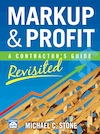I spent time on the phone Monday with a contractor on the east coast. He was frustrated — very frustrated — with how he was being treated by architects.
For starters, the architects were requesting a list of all his subcontractors when he turned in his bid. He said that in the past, they’d used this list to force the general contractor selected to do the work to use the lowest priced sub.
Think about it. If I’m lucky enough to get the job with these architects, I have to agree to use their lowest priced sub so the owner can save money? I’m responsible for building the job, my name is on it, but they choose my subs.
Like what you’re reading? Purchase
Markup & Profit: A Contractor’s Guide Revisited. The basics of running a profitable construction business. Softcover, eBook, and audiobook formats
Order it Here
Hold your breath, pilgrim, it’s not going to happen. If my company (and your company if you’re smart) is going to be responsible for this job, then I am only going to work with the guys I know and trust. My people will do the job right, on time, at the price they agreed to and I know they won’t cause me or my client any problems. That seldom if ever happens with the low-ballers.
My first advice to the contractor was to not work with these architects. If he is going to work with them, he needs to tell them that his list of subs is proprietary information. He will provide it only after he has a signed contract for the job. (And that fixed price contract states that he gets to choose his subs.)
Next: The architects insist on using their contracts. In spite of what you read or hear, I can tell you that as an arbitrator on many construction related projects, the AIA contracts are no better and often much worse than contracts created by the contractor. Yes, they are used a lot by the architectural community but if you do a little research you will quickly find that segment of the construction industry makes up less than 10% of all the work being done. Keep in mind that AIA docs were written by attorneys who were paid by architects to create documents that protect the architect first and the contractor last. Now you tell me, is that a win-win situation?
Finally: The architects told him the overhead and profit margins he could charge.
You know, a smart architect would just stay out of telling a contractor how to price a job. Because contractors can skirt their price demands easily by adjusting their job costs, and the smart ones do. No one can build a job and stay in business with 10% overhead and 10% profit. The sooner architects, owners, insurance companies and others figure that out, the sooner they will get better pricing on their jobs. And the sooner they’ll find themselves working with contractors who will still be in business 2-5 years down the road.
Don’t get involved with anyone who tries to dictate to you how much you can charge for your work. They don’t know enough about your business to even get close to figuring out what your markup needs to be for you to stay in business.
These problems don’t just occur with architects — they can also happen with building owners. There are a lot of people who want you to build their jobs, but they believe they’re smarter than you are and they can tell you how to do business. Don’t put up with it. If you are a responsible business owner, charging a fair price* for the work you do and building the jobs you promise to build in the time frame you promise to build them, then you deserve to be respected for what you do. And part of that respect includes allowing you to run your own business and set your own rules.
*Fair price: The price that allows you to cover all your job costs, your overhead expenses, and make a reasonable profit. No more, no less. Markup & Profit; A Contractor’s Guide Revisited.
The knowledge and experience Michael Stone gained in his 60+ years in construction has helped thousands of contractors improve their businesses and their lives. He is the author of the books Markup & Profit Revisited, Profitable Sales, and Estimating Construction Profitably, and is available for one-on-one consultations.


 wpDiscuz
wpDiscuz